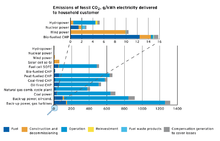- Comparisons of life-cycle greenhouse gas emissions
-
Comparisons of life-cycle greenhouse gas emissions attempt to calculate the emissions of greenhouse gases or solely carbon dioxide over the full life of a power source, from groundbreaking to fuel sources to waste management back to greenfield status.
Contents
2008 Sovacool survey
A meta analysis of 103 life cycle studies by Benjamin K. Sovacool, found that fossil fueled power plants produce electricity with about 443-1050 g equivalent lifecycle carbon dioxide emissions per kWh, nuclear power plants produce electricity with about 66 g (no range given) equivalent lifecycle carbon dioxide emissions per kWh, and renewable power generators produce electricity with 9.5-38 g carbon dioxide per kWh.[1]
Nuclear energy technologies are thus seven to sixteen times more effective than fossil fuel power plants on a per kWh basis at fighting climate change, and renewable electricity technologies are "two to seven times more effective than nuclear power plants on a per kWh basis at fighting climate change". Such estimates already include all conceivable emissions associated with the manufacturing, construction, installation and decommissioning of renewable power plants.[2]
Lifecycle greenhouse gas emission estimates for electricity generators[1] Technology Description Estimate
(g CO2/kWhe)Wind 2.5 MW offshore 9 Hydroelectric 3.1 MW reservoir 10 Wind 1.5 MW onshore 10 Biogas Anaerobic digestion 11 Hydroelectric 300 kW run-of-river 13 Solar thermal 80 MW parabolic trough 13 Biomass various 14-35 Solar PV Polycrystaline silicon 32 Geothermal 80 MW hot dry rock 38 Nuclear various reactor types 66 Natural gas various combined cycle turbines 443 Diesel various generator and turbine types 778 Heavy oil various generator and turbine types 778 Coal various generator types with scrubbing 960 Coal various generator types without scrubbing 1050 2007 Oxford survey
A 2007 report published by the Oxford Research Group listed the following results: coal = 755 g/kWh; natural gas = 385 g/kWh; biomass = 29 - 62 g/kWh; wind = 11 - 37 g/kWh; nuclear = 11 - 130 g/kWh (using the minimum and maximum results amongst 3 studies). The report concluded that "Emissions from nuclear power lie somewhere between biomass and natural gas ... Furthermore, as the available average ore grade declines CO2 (and other Greenhouse Gases) emissions from nuclear power will increase." [3]
Other studies
The Vattenfall study found Nuclear, Hydro, and Wind to have far less greenhouse emissions than other sources represented.[4]
In terms of individual studies, a wide range of estimates are made for many fuel sources which arise from the different methodologies used. Those on the low end tend to leave parts of the life cycle out of their analyses, while those on the high end often make unrealistic assumptions about the amount of energy used in some parts of the life cycle.[5]
The Intergovernmental Panel on Climate Change states that total life-cycle GHG emissions per unit of electricity produced from nuclear power are below 40 gCO2-eq/kWh (10 gC-eq/kWh), similar to those for renewable energy sources. [6]
A study of life-cycle emissions by Swedish utility Vattenfall reported that nuclear power produced 3.3 g CO2/kWh, wind power produced 10, natural gas produced 400 and coal 700.[4]
Another report - Life-Cycle Energy Balance and Greenhouse Gas Emissions of Nuclear Energy in Australia - conducted by the University of Sydney in 2008 produced the following results: nuclear = 60-65 g CO2/kWh; wind power = 20 g/kWh; solar PV = 106 g/kWh. Furthemore, the study criticised the Vattenfall report : "it omits the energy and greenhouse gas impacts of many upstream contributions".[7]
"Hydropower-Internalised Costs and Externalised Benefits"; Frans H. Koch; International Energy Agency (IEA)-Implementing Agreement for Hydropower Technologies and Programmes; 2000.
In a study conducted in 2006 by the UK's Parliamentary Office of Science and Technology (POST), which used figures from the Torness study[8], nuclear power's life cycle was evaluated to emit the least amount of carbon dioxide (very close to wind power's life cycle emissions) when compared to the other alternatives (fossil fuel, coal, and some renewable energy including biomass and PV solar panels). [9]
A 2005 study[10], issued by stormsmith, reported that carbon dioxide emissions from nuclear power plants per kilowatt hour could range from 20% to 120% of those for natural gas-fired power stations depending on the availability of high grade ores.[10]
See also
- Carbon capture and storage
- Efficient energy use
- Environmental effects of nuclear power
- Nuclear power debate
- Relative cost of electricity generated by different sources
- Renewable energy commercialization
External links
- Wise uranium CO2 calculator
- Eddy Covariance Gas Emission Measurements for Scientific and Industrial Applications.
- Power generating equipment efficiency and carbon footprint
References
- ^ a b Benjamin K. Sovacool. Valuing the greenhouse gas emissions from nuclear power: A critical survey. Energy Policy, Vol. 36, 2008, p. 2950.
- ^ Benjamin K. Sovacool. A Critical Evaluation of Nuclear Power and Renewable Electricity in Asia, Journal of Contemporary Asia, Vol. 40, No. 3, August 2010, p. 386.
- ^ Edited by Frank Barnaby, James Kemp (2006). "Secure Energy? Civil Nuclear Power, Security and Global Warming". Oxford Research Group. http://www.oxfordresearchgroup.org.uk/sites/default/files/secureenergy.pdf. Retrieved 2007-07-13.
- ^ a b Vattenfall (2005). "Life cycle assessment: Vattenfall's Electricity in Sweden.". http://www.vattenfall.com/en/file/2005_LifeCycleAssessment_8459810.pdf.
- ^ "Nuclear energy: assessing the emissions". Nature. September 2008. http://www.nature.com/climate/2008/0810/full/climate.2008.99.html. Retrieved 18 May 2010.
- ^ IPCC (2007). "Climate Change 2007: Working Group III: Mitigation of Climate Change". http://www.ipcc.ch/publications_and_data/ar4/wg3/en/ch4s4-3-2.html.
- ^ Lenzen, M. (2008). "Life cycle energy and greenhouse gas emissions of nuclear energy: A review. Energy Conversion and Management 49, 2178-2199". University of Sydney. http://www.isa.org.usyd.edu.au/publications/documents/ISA_Nuclear_Report.pdf. Retrieved 2007-07-13.
- ^ AEA Technology environment (May 2005). "Environmental Product Declaration of Electricity from Torness Nuclear Power Station". http://www.british-energy.com/opendocument.php?did=341. Retrieved 31 January 2010.
- ^ Parliamentary Office of Science and Technology (2006). "Carbon Footprint of Electricity Generation". http://www.parliament.uk/documents/upload/postpn268.pdf. Retrieved 2007-07-13.
- ^ a b Storm van Leeuwen and Philip Smith (2003). "Nuclear Power — The Energy Balance". http://www.stormsmith.nl/. Retrieved 2006-11-10.
Categories:- Greenhouse gas emissions
Wikimedia Foundation. 2010.


